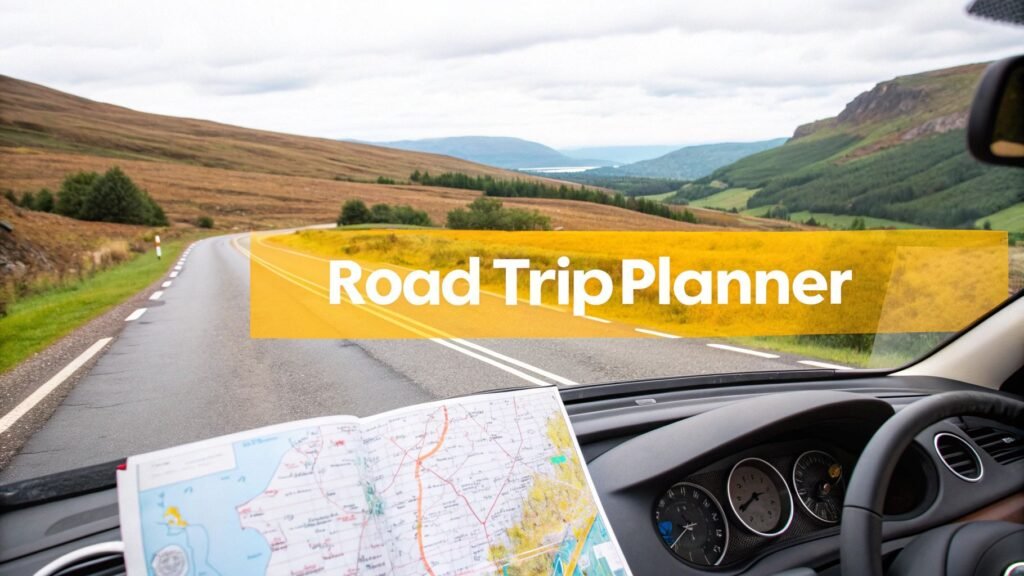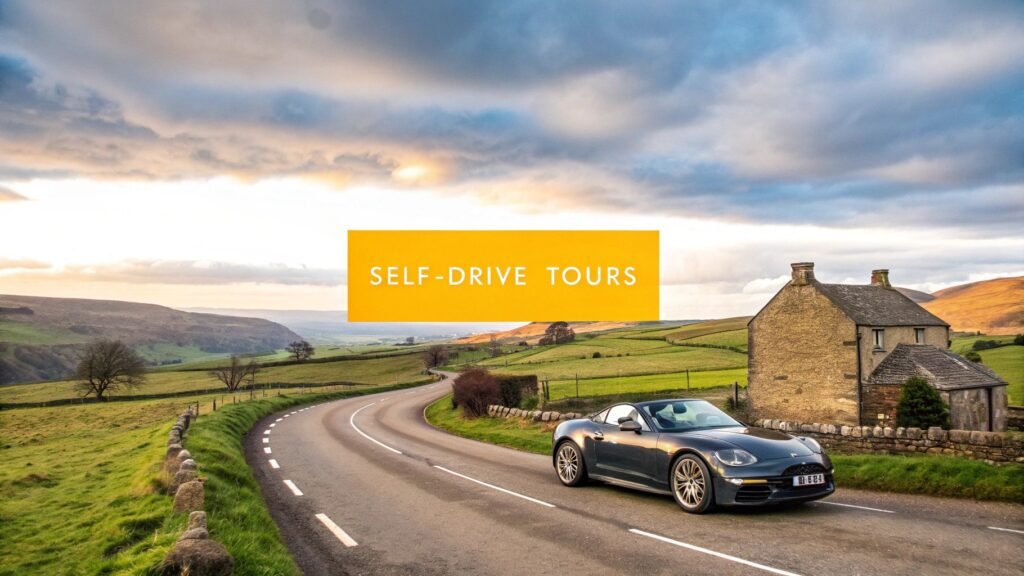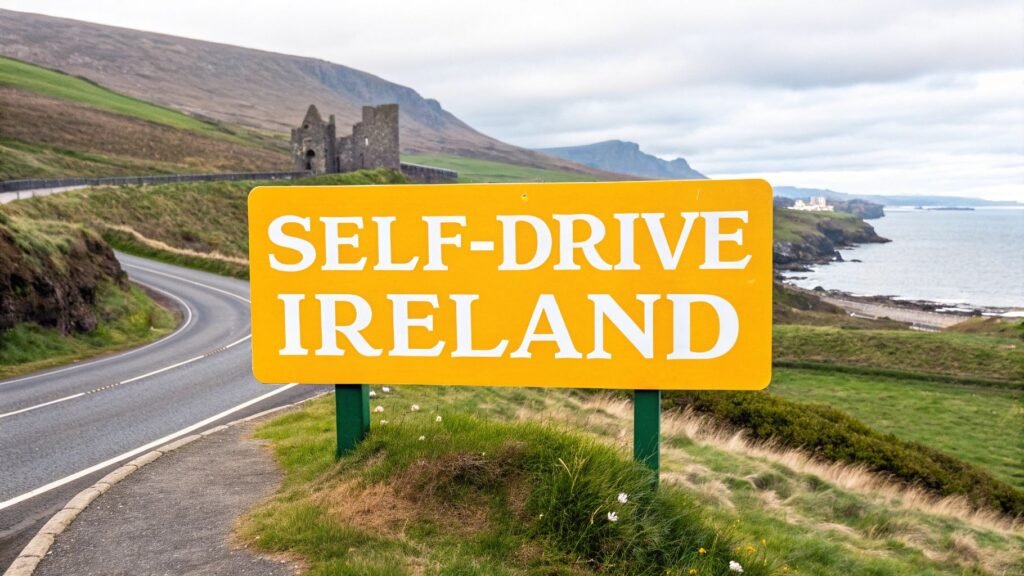A great itinerary is so much more than a map. Think of it as the blueprint for your adventure, the thing that turns a fuzzy idea into a concrete, can't-wait-to-go plan. It's how you strike that perfect balance between hitting the must-see sights and leaving room for those spontaneous discoveries that make a trip truly unforgettable.
Laying the Groundwork for Your UK Road Trip
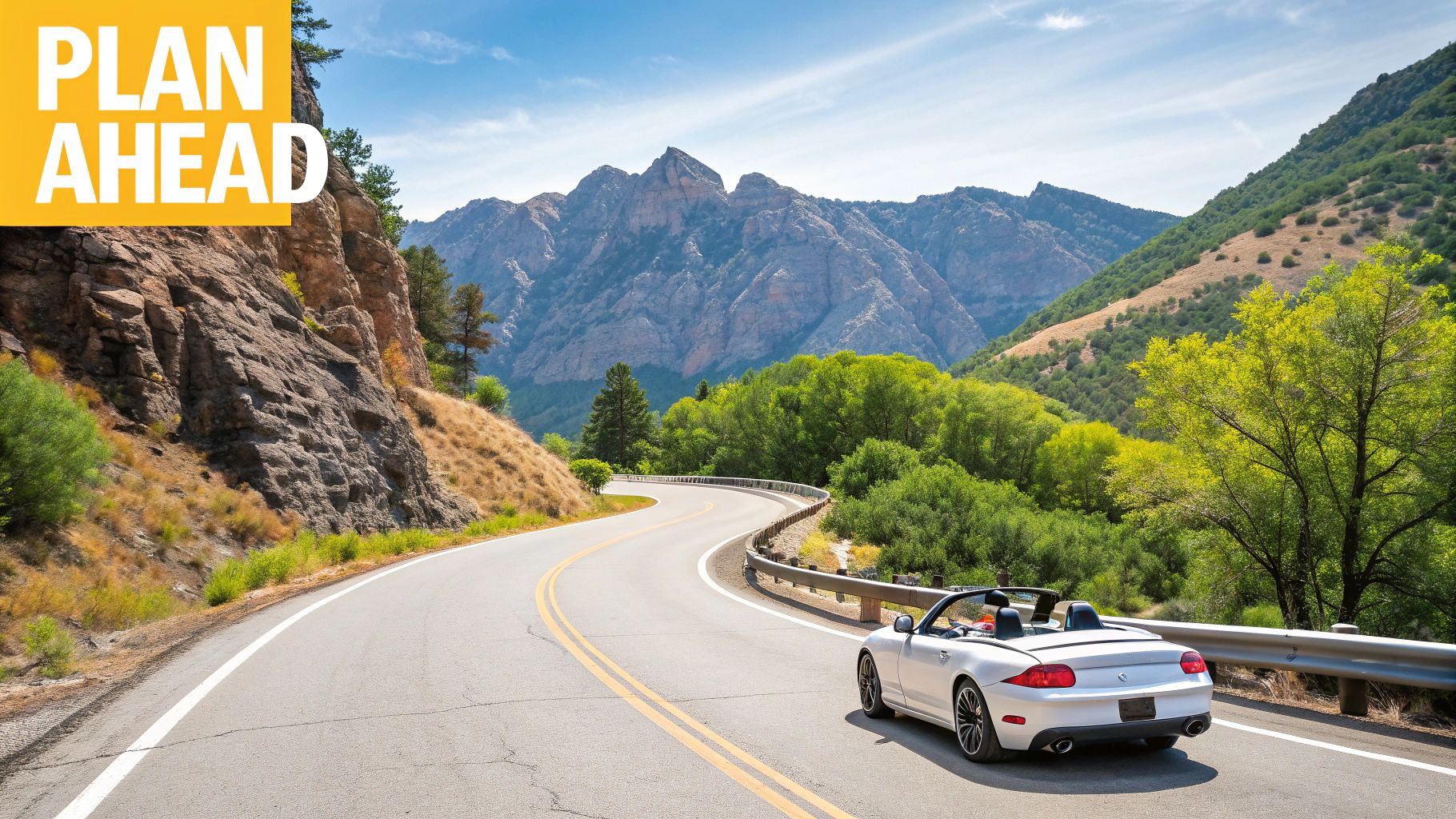
The pull of the open road is a powerful thing, but I’ve learned over the years that the most memorable UK adventures actually begin long before you even turn the key. Try to see this initial planning stage not as a chore, but as the first exciting chapter of your story. This is where a vague dream—say, "a road trip through Scotland"—starts to take real shape.
Think of these foundational steps as your co-pilot, a road trip itinerary planner helping you build an incredible journey from scratch. By going deeper than just a list of places, you can craft a trip that feels like it was made just for you.
Define Your Trip's Purpose
Before you even think about plotting a single point on a map, take a moment to ask the most important question: why am I taking this trip? Seriously, the answer will be your guiding star for every other decision you make, from the route you pick to the budget you set. Are you looking for quiet solitude among the dramatic peaks of Snowdonia, or are you chasing the buzz of vibrant cities like Liverpool and Manchester?
Your travel style is just as important. A family holiday with young kids in tow is going to have a completely different pace and set of activities compared to a solo adventure centred on challenging hikes.
Here’s a quick overview of the essential components to get you started. Answering these questions now will save you headaches down the road.
Your Road Trip's Core Planning Elements
| Planning Component | Key Questions to Ask Yourself | Example Focus |
|---|---|---|
| Pacing | Do I want to see everything, or savour a few places? How many hours of driving per day is comfortable for me? | A relaxed, 10-day trip with a max of three hours of driving per day, versus a packed itinerary with six-hour drives. |
| Interests | Am I a history buff, a foodie, a hiker, or all three? What's the main theme of this adventure? | Focusing on historic castles in Wales, sampling regional whiskies in Scotland, or discovering hidden coastal paths in Cornwall. |
| Companions | Am I travelling solo, as a couple, with friends, or with my family (and kids)? | A solo trip might prioritise budget-friendly hostels, while a family holiday will need family rooms and kid-friendly activities. |
Getting real about your priorities from the get-go is key.
- Pacing: Do you prefer packing your days full, or do you enjoy a more leisurely pace with plenty of time to just be? A 10-day trip with a maximum of three hours of driving each day feels vastly different from one where you're on the road for six hours.
- Interests: Is your main goal to explore crumbling castles, hunt down the best local food, or discover hidden coastal paths? Nailing down a theme really helps narrow down the overwhelming number of options out there.
- Companions: Are you flying solo, road-tripping with a partner, or bringing the whole family along? This one factor massively influences your accommodation, daily budget, and the kinds of experiences you'll be looking for.
A well-defined purpose is the cornerstone of any great road trip. It stops you from over-scheduling and makes sure every day on the road aligns with the kind of adventure you actually want.
By realistically mapping out your timeframe, budget, and travel preferences right at the start, you sidestep common traps like running out of money or feeling constantly rushed. Think of this as laying a solid foundation for an adventure that’s not just scenic, but perfectly paced and uniquely yours.
Designing Your Route for Scenery and Sense
This is the fun part, where the vague idea of a road trip starts to look like a real adventure on a map. Planning your route is so much more than just connecting dots. It's about consciously choosing the roads that will give you the feeling you're after. Are you looking for the quick, no-fuss efficiency of a motorway? Or is the whole point to meander down winding country lanes and see what you stumble upon between the big-ticket sights?
A good road trip itinerary planner these days is all about mixing the old with the new. I usually start with something familiar like Google Maps to get a feel for the major routes and how far apart things really are. Then, I’ll layer on more specialised apps to start pinpointing hidden gems, great overnight stops, and those little detours that make a trip unforgettable.
Balancing Speed with Discovery
At its heart, every road trip plan comes down to a simple choice: the fast route or the scenic route.
Let's say you're plotting a drive from London up to the Lake District. The most obvious way is to just blast up the M6. It's efficient, sure, but you won't see much beyond tarmac and service stations.
A far more memorable option might be to swing west first, weaving your way through the Cotswolds. Yes, it adds a good few hours to your driving time, but it completely changes the nature of the day. Suddenly, a boring transit becomes an experience filled with honey-coloured villages and stunning landscapes. There’s no right or wrong answer here; it’s all about what you want to get out of the trip.
This visual guide breaks down a simple, effective way to structure your driving days.
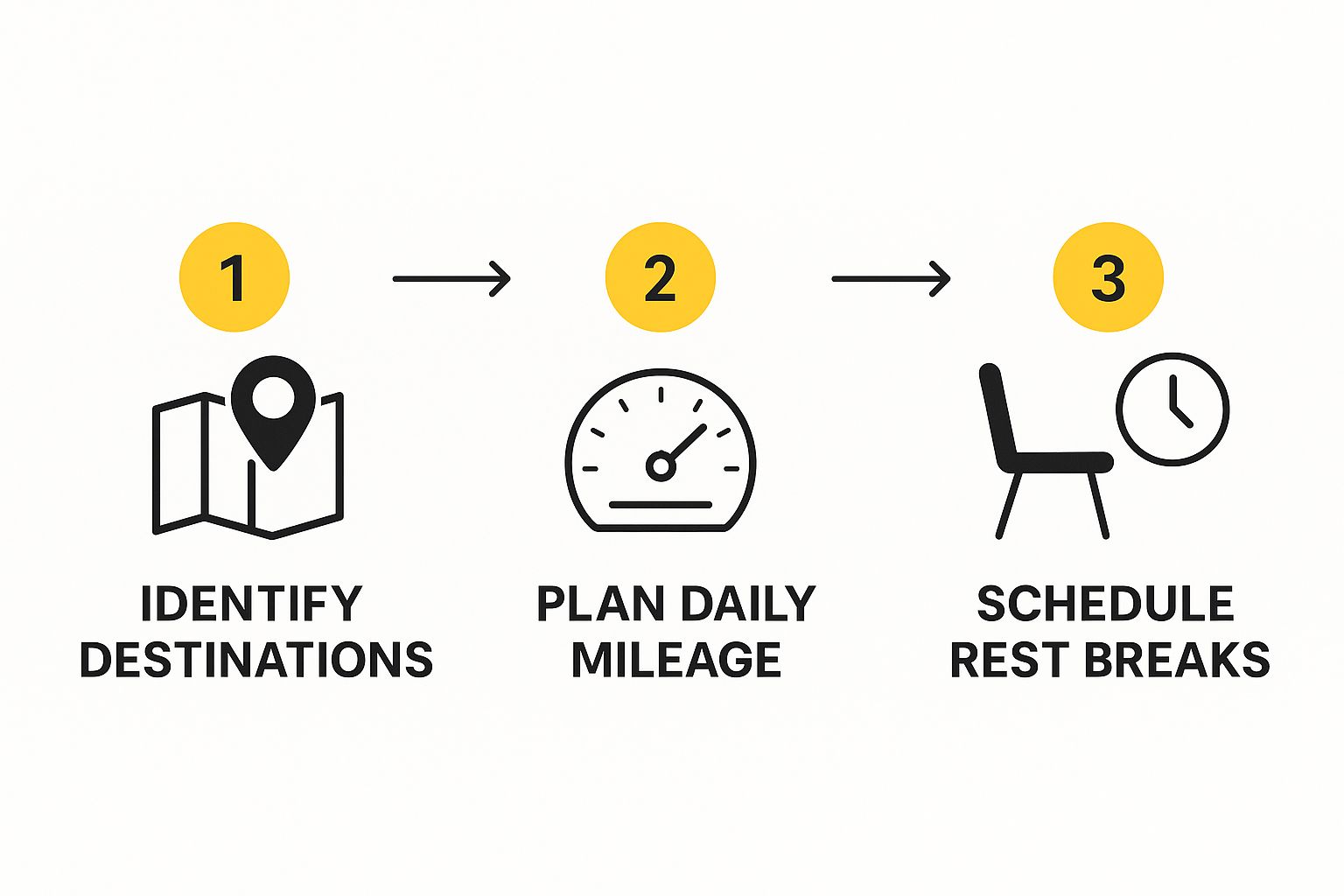
Starting with your key stops and then slotting in breaks is the best way to build a plan that’s both exciting and realistic.
It’s a classic rookie mistake to underestimate just how long it takes to drive on smaller roads. The numbers back this up. Of the 335.9 billion vehicle miles driven in Great Britain recently, a whopping 148.7 billion miles were on 'A' roads. That’s more than double the 69.9 billion miles on motorways. It shows that most of us are choosing these more local, scenic routes for leisure, which means you absolutely have to plan for a slower pace. You can explore more about UK traffic patterns to see for yourself.
Calculating Realistic Daily Drives
Once you have a rough path sketched out, it's time to chop it into daily, bite-sized chunks. The biggest trap people fall into is trusting the drive time estimate from a mapping app. Those numbers are pure fantasy—they never account for real life.
A three-hour estimated drive can easily stretch to four or five hours once you factor in a stop for a decent coffee, a spontaneous photo opportunity, a fuel top-up, and the inevitable traffic jam near a popular town.
My personal rule of thumb is to add at least 25-30% to whatever time Google Maps spits out. If it says a journey will take four hours, I budget five. Minimum. This buffer is your best friend; it gives you the freedom to pull over and explore without constantly watching the clock.
- For short trips (3-4 days): I’d aim for no more than 3-4 hours of actual driving each day. This leaves plenty of time to properly enjoy each stop.
- For longer journeys (7+ days): It's fine to have a couple of longer driving days (5-6 hours) to cover serious ground, but always follow them with shorter, more relaxed days. Trust me, it’s the best way to avoid road trip burnout.
Mapping Out Your Stops and Alternatives
With your daily mileage looking sensible, you can start populating your map with the good stuff. This isn't just about where you'll sleep for the night; it's about everything in between.
I like to use a simple layering system on my map planner:
- Must-Sees: These are the non-negotiables, the absolute cornerstones of the trip.
- Maybes: Think of these as bonus points. A fantastic viewpoint, a pub with rave reviews, or a short walking trail you could do if you’re ahead of schedule.
- Practical Stops: This is a lifesaver. Pinpoint potential lunch spots, scenic picnic areas, and clean public toilets in advance. Knowing where these are saves so much aimless driving and stress.
And my final piece of advice: always have a Plan B. What happens if that main road is closed for an accident? Having a backup route or a different point of interest in your back pocket means a small hiccup won't derail your entire day. That kind of flexibility is the secret ingredient to a genuinely brilliant road trip.
Booking Smart for Stays and Experiences
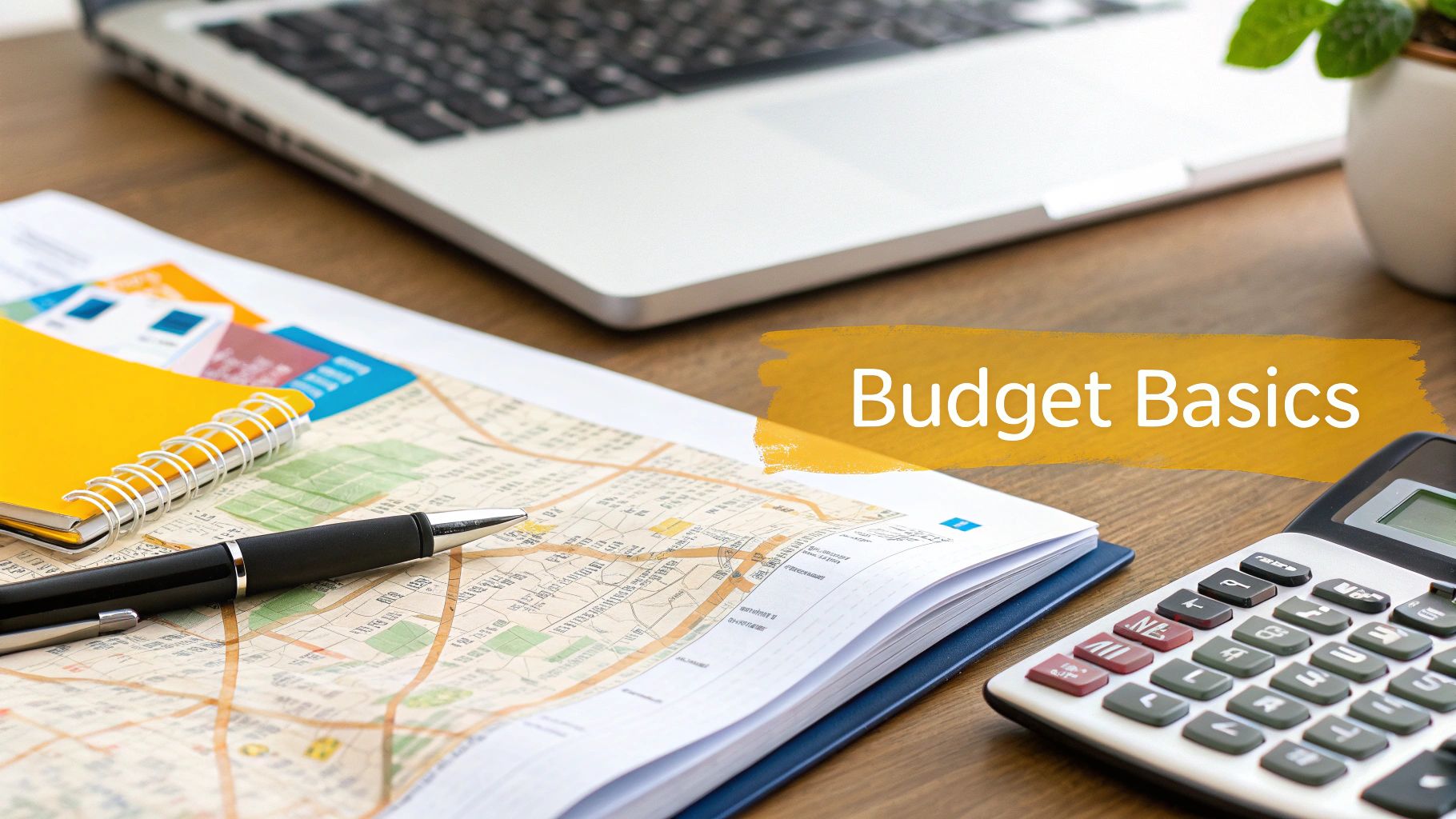
With your route roughly sketched out, the trip finally starts to feel real. Now for the part that anchors it all in place: booking where you'll sleep and what you'll do. This isn't just a box-ticking exercise; it's where you start to colour in the details and shape the feel of your adventure. Your choice of lodging can define a day just as much as a famous landmark.
Getting this right is crucial. You want your accommodation to feel like a natural part of the journey, not a logistical headache. Deciding between a cosy bed and breakfast in the Cotswolds or a self-catering cottage on the Cornish coast has a real impact on your daily routine, your budget, and even the food you eat.
Finding Your Accommodation Sweet Spot
The UK has a fantastic variety of places to stay, each with its own character. A country pub with rooms upstairs offers a totally different vibe to a slick city-centre hotel. Think about what fits the 'why' of your trip. If you’re chasing authentic local flavour, a family-run B&B is a brilliant choice for getting insider tips over breakfast. On a tighter budget or travelling with family? A self-catering spot gives you flexibility and saves money.
The big question is always when to book. While spontaneity sounds romantic, rocking up to a popular village in the Lake District in August without a reservation is a recipe for disaster. For peak season travel (June-August) or over bank holiday weekends, booking accommodation 3-6 months in advance is essential. During the off-season, you can afford to be more relaxed, perhaps booking just the first and last nights and leaving the middle open for discovery.
Here’s a quick rundown to help you decide what's right for your journey:
| Accommodation Type | Best For | Booking Tip |
|---|---|---|
| Hotels & Inns | Convenience and services | Perfect for city stops or when you just want a comfy bed without any fuss. |
| B&Bs / Guesthouses | Local insight and charm | You can't beat getting recommendations from hosts who know the area inside out. |
| Self-Catering | Budget control and flexibility | A great choice for families or longer stays, allowing you to cook your own meals. |
| Unique Stays | Memorable experiences | Think shepherd's huts or glamping pods. Book these as far in advance as possible. |
A well-balanced road trip itinerary often features a mix of pre-booked stays for key locations and a night or two left open for those "let's see where the road takes us" moments.
This planning is even more important when you realise how popular domestic travel is. In a recent quarter alone, UK residents took 22.03 million overnight trips within Great Britain, spending a massive £7.76 billion. With the average trip lasting 2.7 nights, the competition for the best spots is fierce. You can find more details on these UK domestic travel trends from recent statistics.
Securing Your Must-Do Experiences
Beyond where you'll sleep, think about what you absolutely have to do. For some high-demand attractions, booking ahead isn't just a good idea—it's the only way you'll get in without disappointment or spending half your day in a queue. We’re talking about places like the Warner Bros. Studio Tour London, Edinburgh Castle during the festival, or getting a timed slot for Stonehenge.
Leaving these key bookings to chance can throw an entire day off course. A bit of forward planning means you’ll spend your holiday making memories, not standing in line.
Start by making a 'must-do' list for each leg of the journey. For each one, do a quick bit of research:
- Opening Times and Days: Don't get caught out by arriving when it’s closed. Always check the official website for the most current information.
- Ticket Costs: Look for different ticket options. Sometimes an 'early bird' ticket is cheaper, or a family pass offers better value.
- Booking Windows: Some popular tours release tickets months in advance and they sell out fast. Pop a reminder in your calendar.
Once you have this info, you can slot these fixed appointments into your daily schedule. For example, with a 10 am ticket for the Tower of London, you can plan your morning around it, knowing exactly where you need to be and when. This structure gives you the confidence to build the rest of your day, fitting in more spontaneous activities around your pre-booked highlights. This is the mark of a truly effective road trip itinerary planner—one that gives you both structure and freedom.
Budgeting and Prepping Your Vehicle for the Road
Even the most perfectly planned route can fall apart because of two things: money worries and car trouble. A solid budget and a reliable vehicle are the unsung heroes of any great UK road trip. Getting these sorted before you go is what separates a stressful journey from a relaxing adventure.
Think of your budget as a framework for freedom, not a set of chains. It shows you where you can splash out and where you need to be a bit more savvy, making sure you come home with incredible memories instead of a financial hangover.
Crafting a Realistic Road Trip Budget
First things first, let's break down the costs into manageable chunks. Fuel is often the biggest line item, so use a route planner to get a rough idea of your mileage and then a fuel cost calculator to put a number on it. Just remember, those winding country lanes will drink more fuel than a steady cruise on the motorway.
Beyond the pump, you'll want to think about these key areas:
- Accommodation: This is usually the largest single cost, unless you're planning to camp.
- Food and Drink: A healthy mix of dining out and self-catering is often the best approach. Budget for a few special pub lunches or dinners, but balance it with picnics and supermarket runs.
- Activities and Tickets: It’s a good idea to pre-book major attractions to lock in the cost and, more importantly, avoid the disappointment of a "sold out" sign.
- Contingency Fund: I can't stress this enough: always have an emergency fund. I recommend setting aside 10-15% of your total budget for the unexpected, whether that's a parking fine, a last-minute tour, or a souvenir you simply can't leave behind.
A well-thought-out budget doesn't just manage your spending; it empowers your decisions on the road. Knowing you have a cushion for a spontaneous detour or a fancy meal removes the anxiety from saying "yes" to unexpected opportunities.
A self-drive tour can actually be a fantastic way to manage expenses. If you want a bit of inspiration, have a look at a structured itinerary like the Taste of England 8-day self-drive tour. It’s a great benchmark for seeing how costs and experiences can be balanced.
Getting Your Vehicle Road-Ready
Once your finances are in order, it’s time to turn your attention to your most important piece of kit: your car. Nothing derails an amazing trip faster than a breakdown, but a few simple checks can make a world of difference. You don't need to be a mechanic to cover the basics.
Give your car a thorough once-over about a week before you set off. That leaves you plenty of time to sort out any little issues you might find.
The Essential Pre-Trip Vehicle Checklist
- Tyres: Check the pressure on all four tyres—and don't forget the spare! While you're at it, inspect the tread. The legal minimum tread depth in the UK is 1.6mm.
- Fluids: Top up your oil, coolant, and windscreen washer fluid. These are simple but absolutely vital for keeping your engine happy and your view clear.
- Lights and Wipers: Get a friend to help you test all your lights—headlights, indicators, and brake lights. And given the UK's famously unpredictable weather, check your wiper blades for any splits or wear.
- Brakes: When you’re driving, listen for any grinding or squealing sounds. If you notice anything that doesn't feel or sound right, get them looked at by a professional straight away.
Thinking beyond the car itself, good visibility is paramount, especially if you’ll be driving after dark. This helpful guide to night driving glasses for road safety has some great tips on how specialised eyewear can make a real difference.
Finally, put together a small roadside emergency kit. It should have a first-aid kit, a torch, jump leads, a high-vis jacket, and a warning triangle. Having these on hand gives you peace of mind, letting you focus on what really matters: the beautiful journey ahead.
Using BTOURS to Elevate Your Itinerary
There’s a real satisfaction in piecing together a road trip plan from scratch, I get it. But sometimes, using a specialised road trip itinerary planner can be the difference between a good trip and a truly brilliant one. This is where a platform like BTOURS comes into its own, taking the headache out of the finer details of UK travel by giving you professionally designed itineraries you can make your own in minutes.
The biggest advantage? You're not starting with a blank map and a world of overwhelming choice. Instead, you begin with a proven framework—maybe a 'Classic Scotland Whisky Trail' or a 'Coastal Wales Adventure'—that already connects the dots logically and beautifully. This simple shift saves you countless hours of research but leaves all the creative control firmly in your hands.
From Template to Tailor-Made Journey
The real magic of using a tool like BTOURS is its flexibility. You’re not boxed into a rigid schedule. Think of it less as a fixed plan and more as a professional-grade blueprint that you can tweak to fit your pace, your budget, and what you really want to see.
This is what sets a premium planner apart. You can see, instantly, how one small change affects the rest of your trip. Fancy an extra day exploring the charming villages of the Cotswolds? The planner automatically shuffles the following days. Stumbled upon a boutique hotel you’re dying to stay in? Swap it out and watch your budget update in real time.
Here’s a quick look at how our platform lays out these journeys, making it easy to picture yourself there.
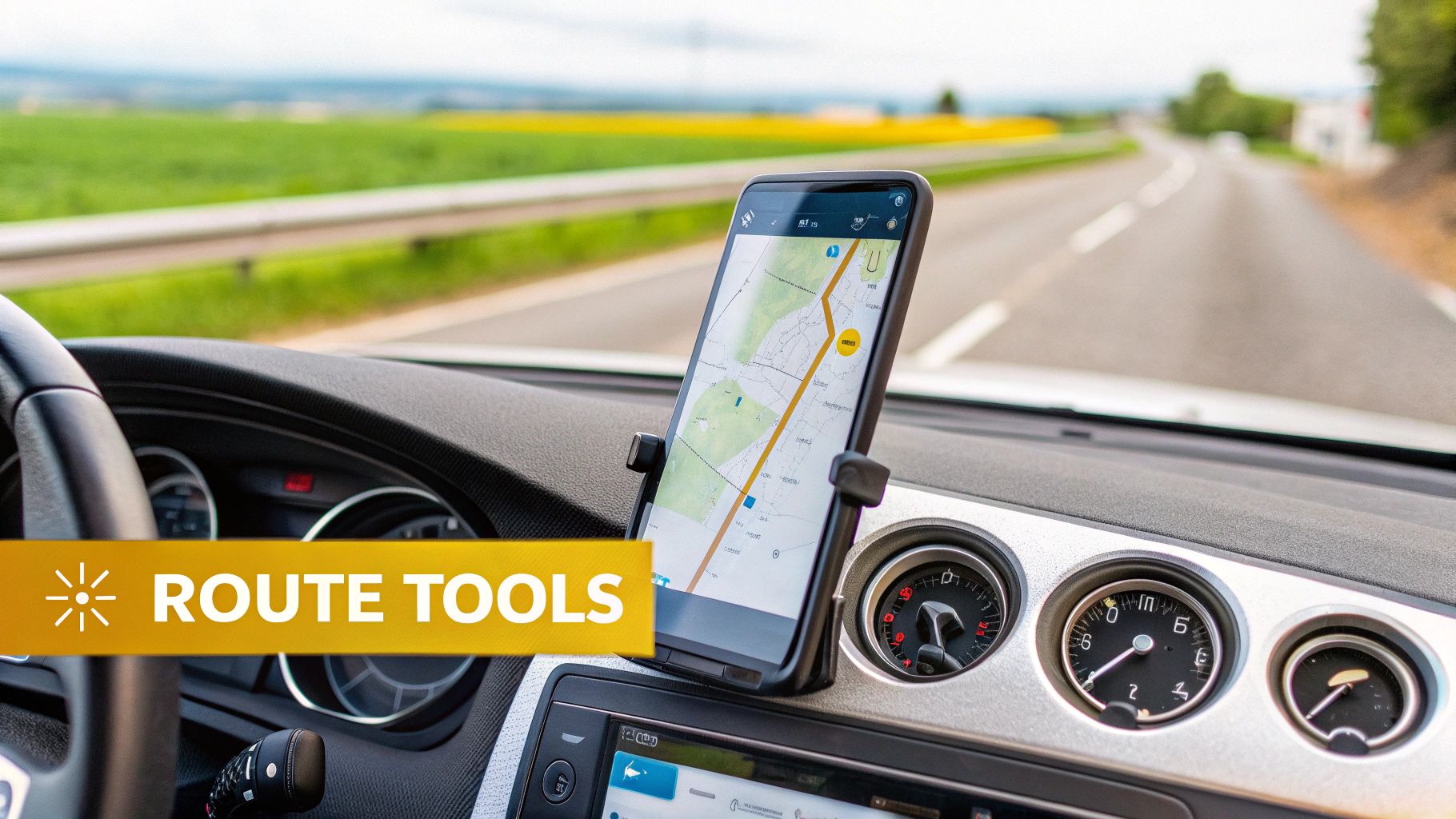
The clean, visual layout helps you find a tour that sparks your interest straight away, whether you're a history buff, a nature lover, or a foodie.
This blend of expert guidance and personal freedom is crucial. The UK tourism industry recently contributed a massive £286 billion to the national GDP, and with 43.4 million inbound visits on the horizon, the appetite for well-planned travel has never been greater. A smart road trip planner meets this demand by turning logistical nightmares into a smooth, enjoyable experience.
Making It Your Own: A Real-World Example
Let's see how this works in practice. Say you're looking at our Taste of Scotland 8-Day Self-Drive Tour. The base itinerary is a belter, hitting Edinburgh, Loch Ness, and the Isle of Skye. But you're a keen hiker and have always wanted to tackle Ben Nevis.
With a traditional plan, this would mean a lot of backtracking and recalculating. Here, you just add the activity. The BTOURS planner then gets to work:
- It adjusts your schedule: The system might suggest adding an extra night in Fort William, so you have a full day for the hike without feeling rushed.
- It updates your budget: The cost of a guided climb and the extra night's stay are automatically added to your total trip cost. No surprises.
- It suggests logistics: It can even recommend local guides and check that your driving times for the next leg of the journey are still realistic.
It’s a world away from juggling spreadsheets, booking sites, and map apps. It’s one seamless system where a single change intelligently updates everything else.
A great road trip itinerary planner doesn’t just show you a route; it understands the relationship between your time, budget, and interests, allowing you to make informed decisions effortlessly.
The BTOURS Advantage: What We Handle for You
Ultimately, a tool like this does the heavy lifting, so you can focus on the fun stuff. We take care of the time-sucking tasks that often drag down the planning process.
This includes things like:
- Vetted Accommodations: We’ve already hand-picked a range of fantastic hotels, B&Bs, and inns. That means no more scrolling through hundreds of reviews hoping to find a good one.
- Logical Routing: Our routes are designed by UK travel experts. They’re efficient, scenic, and practical, built to avoid backtracking and ridiculously long days behind the wheel.
- Curated Experiences: We suggest top-rated tours, must-see attractions, and a few hidden gems along your route, which you can easily add or ignore as you please.
By handling these core components, BTOURS lets you become the architect of your own perfect UK road trip. We provide the structure and the tools; you provide the vision for an unforgettable, and truly personal, adventure.
A Few Common UK Road Trip Questions Answered
Even with the most meticulously crafted plan, a few questions are bound to pop up. That’s perfectly normal. Getting these common queries sorted will give you that extra bit of confidence to fine-tune your UK adventure and hit the road knowing you’re ready for anything.
Think of this as the final polish on your itinerary. We’ve pulled together some of the most frequent questions we get from travellers and answered them with practical, no-nonsense advice to help you nail down those last few details.
What Is the Best Time of Year for a UK Road Trip?
When you should travel really comes down to the kind of experience you’re after. Each of the UK’s seasons brings a completely different flavour to a road trip.
Summer, from June to August, is easily the most popular choice, and for good reason. You get the longest days and the warmest, most dependable weather—perfect for hitting the beaches in Cornwall or hiking through the Peak District. The trade-off, of course, is that it’s peak season. Expect bigger crowds at popular spots and higher price tags on accommodation.
For what I think is a fantastic balance, look at the shoulder seasons:
- Late Spring (April-May): The countryside just bursts into colour, the weather is often surprisingly lovely, and you get to enjoy it all before the summer crowds descend.
- Early Autumn (September-October): This is my personal favourite. You’re treated to those gorgeous autumn colours, the temperatures are still mild, and attractions are generally much quieter.
A winter road trip can be absolutely magical, especially a drive through the snow-dusted Scottish Highlands, but it does demand more careful planning. You'll have to work with much shorter days and be prepared for potential weather-related disruptions on the road.
How Much Should I Budget per Day?
This one can vary massively, but you can definitely work out a solid estimate. For a comfortable, mid-range UK road trip, I’d suggest budgeting between £100-£150 per person, per day. This figure usually doesn't include your accommodation, which will almost always be your single biggest expense.
So, what does that daily budget cover?
- Fuel for the car
- Food (think a mix of pub lunches, café stops, and supermarket snacks)
- Entry fees for one or two main attractions
- Little extras like parking fees or a well-deserved coffee
To keep a lid on costs, try mixing in picnics or grabbing lunch from a local bakery. Booking accommodation with a small kitchenette is another brilliant way to save by making your own breakfast or the odd simple dinner. And don't forget, many of the UK's best museums and national parks are completely free to enter! For more detailed advice on planning, check out our guide on crafting the perfect journey on our blog.
Should I Rely on GPS or Bring Paper Maps?
Honestly, the smartest move is to use both. A GPS or a navigation app like Google Maps on your phone is a godsend for real-time traffic updates and turn-by-turn directions through hectic towns and cities. It just removes the stress of navigating complicated junctions.
But having said that, a physical road atlas is an invaluable backup that you really shouldn't leave home without.
In remote areas of the UK—places like the Scottish Highlands, rural Wales, or the North York Moors—mobile signal can be patchy or disappear altogether. Your GPS is useless without a signal, but a map never runs out of battery.
A paper map also gives you a far better sense of the bigger picture. It makes it so much easier to spot interesting-looking B-roads or potential scenic detours that a GPS, with its laser focus on the most efficient route, would probably never show you.
What Are the Biggest Planning Mistakes to Avoid?
The most common mistake I see people make is over-scheduling. It’s so tempting to try and cram every last thing into each day, but that’s the fastest route to road trip burnout. You end up just rushing between points on a map instead of actually enjoying the journey itself. Always build some breathing room into your road trip itinerary planner.
Another classic pitfall is underestimating how long it takes to get anywhere. A 50-mile drive on winding, single-track country lanes can easily take double the time it would on a motorway. As a rule of thumb, always add at least 25% to the estimated drive times you see on apps.
Finally, failing to pre-book key attractions or your accommodation, especially in peak season, can lead to real disappointment. There's nothing more frustrating than driving three hours to see a famous castle, only to find it's sold out for the day. A little bit of forward planning prevents that headache entirely.
Ready to stop planning and start exploring? With BTOURS, you can choose from expertly crafted self-drive tours across the UK and customise them to create your perfect adventure. Let us handle the details, so you can focus on the road ahead.

